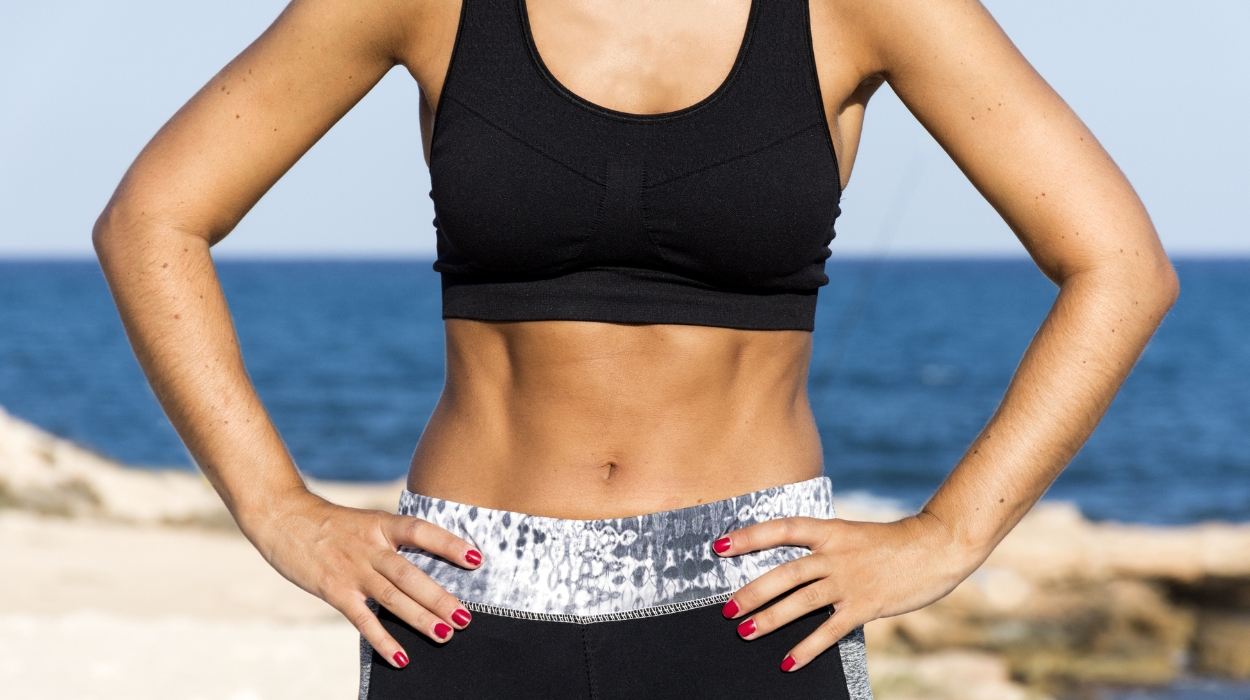It’s always a challenging issue shedding stubborn lower belly fat. But once you find a way to do it, it positively impacts your life.
Losing belly fat can result in immeasurable health benefits, such as improved mental, cardiovascular, and respiratory well-being.
Here we will look at eight straightforward methods to help you shed stubborn lower belly fat. We’ll also delve into dietary adjustments, effective exercise routines, and lifestyle choices that promote sustainable results. However, be aware that it’s not possible or safe to lose weight overnight.
Effective Tips To Lose Lower Belly Fat
Here are 8 effective tips on how to lose lower belly fat:
- Maintain a balanced diet with a calorie deficit.
- Incorporate high-intensity exercises.
- Focus on strength and resistance training.
- Include aerobic workouts in your routine.
- Prioritize sleep and manage stress.
- Reduce liquid calorie intake.
- Limit consumption of trans fats.
- Explore intermittent fasting for fat loss.
How To Lose Lower Belly Fat?
How to get rid of lower belly fat can be daunting, especially if you have no idea how to do it. In this section, we’ll unveil eight strategies to help you shed lower belly fat quickly and efficiently.
These strategies include dietary choices, exercise routines, and lifestyle adjustments. Please note that most of these strategies work together to provide you with a comprehensive roadmap to achieve your goals.
Maintain A Balanced Diet With A Calorie Deficit

The number one diet remedy for losing lower belly fat is to achieve a caloric deficit using a balanced diet. A calorie deficit is when you consume fewer calories than your body needs. This forces the body to tap into stored fat for energy.
When combined with a low-carb diet, a caloric deficit can help regulate blood sugar levels[1] and reduce body fat,[2] including stubborn belly fat.
Here is a list of the nutrients that make up a balanced diet:
- Macronutrients: Carbohydrates, proteins, and fats for energy, repair, and growth.
- Micronutrients: Vitamins and minerals for immunity, cell growth, and metabolic health.
When you focus on nutrient-rich, natural foods and herbs, you can create a sustainable weight-loss plan. You may also get rid of water weight through a balanced diet by reducing[3] salt intake.
Incorporate High-Intensity Exercises
High-intensity exercises are those with fast-paced movements with minimal rests in between sets. This workout may include high-intensity interval training, i.e., HIIT, and selected abdominal exercises. The research suggests they significantly boost your metabolism[4] and help burn calories more effectively.
When you engage in high-intensity exercises targeting abdominal muscles, you maximize the fat-burning potential of your workouts. This is an excellent way to target visceral fat and reduce body fat percentage.[5]
Here is a simple HIIT workout you can use for lower belly fat loss:
Warm-up
- Five minutes of light cardio, such as jogging or jumping jacks.
Workout
| Exercise | Duration |
| Burpees | 30 seconds |
| Mountain Climbers | 30 seconds |
| Leg Raises | 30 seconds |
| Russian Twists | 30 seconds |
Rest for one minute, then repeat the circuit three to five times.
Cool-down
- Five minutes of light cardio and stretching.
Focus On Strength And Resistance Training
Strength and resistance training are exercises that entail lifting weights. Strength training is progressively working a muscle to allow it to grow in strength over time. Resistance training uses resistance to build muscle strength, endurance, and power. For weight training, you can use free weights, weight machines, resistance bands, or even your body weight.
Research on resistance training shows it aids visceral fat loss and weight[6] maintenance.
These workouts are best for building muscle mass, but they are also excellent for reducing lower body fat. Here is a list of exercises that may aid lower belly fat loss:
- Squats.
- Deadlifts.
- The Bench Press.
- The Overhead Press.
- Pull-ups.
- Rows.
- Lunges.
- Kettlebell Swings.
- Battle Ropes.
- Medicine Ball Slams.
- Box Jumps.
Include Aerobic Workouts In Your Routine

Aerobic workouts entail movements such as running, swimming, or cycling. These exercises are fantastic for overall fat loss, including reducing belly fat.
They increase your heart rate and enhance your body’s ability to burn fat during and after the workout. According to research, aerobic training is more efficient at reducing fat mass and promoting weight loss[7] than resistance training.
Here is a list of aerobic movements that may aid in lower belly fat loss:
- Running.
- Biking.
- Swimming.
- Dancing.
- Elliptical Training.
- Stair Climbing.
- Rowing.
- High-Intensity Interval Training.
You can perform these exercises individually or in combination. For instance, start with a five-minute warm-up of cycling, followed by a 20-minute HIIT workout, and end with a five-minute cool-down of stretching.
Prioritize Sleep And Manage Stress
Getting adequate sleep and stress-free is vital for healthy weight loss. This is because sleep regulates hunger hormone production,[8] and a lack of sleep increases insulin resistance.[9] When you are also highly stressed, this can lead to emotional eating, poor lifestyle choices, and further sleep deprivation.[10]
The remedy is to get adequate sleep and use stress management techniques. Getting a good amount of sleep may lower fat accumulation[11] and lower stress hormone levels. Adults should prioritize getting at least 7 to 9 hours[12] of sleep daily.
The stress management techniques that could aid weight loss are:
- Relaxation techniques such as yoga,[13] meditation,[14] and deep breathing.[15]
- Seeking professional help.
Reduce Liquid Calorie Intake
Liquid calories are present in everyday beverages like sugary drinks, fruit juices, or even coffee or tea with added milk, cream, and sugar. Soft drinks contain too many calories that have a weight gain effect[16] even if you are physically active.
Without moderation, this excess sugar consumption can significantly contribute to weight gain and belly fat. Limiting your liquid calorie intake is a simple yet effective way to create a calorie deficit. In this state, you can better reduce your belly fat by incorporating exercises targeting your midsection.
The best alternatives are water, herbal teas, or other low-calorie beverages.
Limit Consumption Of Trans Fats
Dietary fats are divided into three main types: saturated, unsaturated, and trans.
Saturated fats are solid at room temperature and are mainly animal fats. Unsaturated fats are liquid at room temperature and can be both plant or animal fats. These also come as monosaturated or polyunsaturated based on the number of double bonds in their chemical structure.
Trans fats are unsaturated fats created when liquid oils are hydrogenated to make them solid at room temperature. They are present in shortenings, margarine, and in many processed foods.
These trans fats have the negative effect of increasing abdominal fat accumulation[17] and raising the risk of heart disease.[18] Deliberately eliminating trans fatty acid foods such as processed and fried foods helps you decrease the amount of belly fat your body stores.
Explore Intermittent Fasting For Fat Loss
Fasting is the practice of rearranging your eating schedule by eliminating a meal or meals. The main goal is usually to limit lower calorie intake, which leads to weight loss. Intermittent fasting may boost metabolism,[19] reduce insulin levels,[20] and improve insulin resistance.[20]
Intermittent fasting may boost your metabolism by triggering periods of ketone production.[21] Ketones are more efficiently burned than glucose. They have several other benefits, such as suppressing appetite and improving insulin sensitivity. Therefore, a boosted metabolism may facilitate faster burning of excess belly fat. Reduced insulin levels mean lower fat storage and better appetite control. With improved insulin resistance, you may also notice reduced food cravings[22] and less fat accumulation.
What Is Lower Belly Fat?
Lower belly fat is often called lower abdominal fat or the lower belly pooch. This refers to the visceral fat that accumulates at the very bottom part of the front abdomen.
Subcutaneous fat feels soft and lies just beneath the skin, while visceral fat is stored around internal organs. The latter is stored under the abdominal muscles and hence feels hard.
Lower belly fat can be quite stubborn to get rid of. However, understanding the forming nature of lower belly fat and how to address it effectively is paramount.
The issue with this is that our bodies store fats differently. The excess fat in this region can result from various factors, including genetics and a sedentary lifestyle. Additional causes are unhealthy eating habits and hormonal changes.
A bulky lower belly can be a cosmetic concern and indicate a far more deep-seated health issue. Belly fat, especially excess visceral fat, is associated with a higher risk of cardiometabolic risk factors.[23] These are the factors that increase serious health risks like developing cardiovascular disease and metabolic diseases, such as type 2 diabetes. Examples of these factors are:
- High blood pressure.
- High blood sugar.
- High cholesterol.
- Obesity.
- Physical inactivity.
- Smoking.
The eight remedies we have covered above may help you better regulate some of these factors.
How Long Does It Take To Get Rid Of Lower Belly Fat?
It is unrealistic to set a time when you will finally lose your lower belly pouch and reframe your body composition. This is because the duration it takes to get rid of lower visceral belly fat varies from person to person. A steady weight loss process relies on several factors, including the starting point, the selected technique, and commitment.
Getting to a flatter tummy often hinges on fitness, mental, lifestyle, and diet-related factors. On diet-related factors, maintain a balanced diet with a calorie deficit, limit liquid calories, and eliminate trans fat ingestion. Intermittent fasting may also speed up the process.
On fitness, there is incorporating high-intensity exercises, strength and resistance training, and aerobic workouts. Simple everyday physical activity like climbing stairs may help.
Lifestyle-related remedies such as getting adequate sleep and managing stress will speed up the process.
Incorporating all the above in losing belly fat, you may see noticeable changes within a few weeks. Nonetheless, the significant and sustainable results will take several months.
Spot reduction is challenging, so going with an overall body fat reduction mission is often the most effective approach. Additionally, practice patience, consistency, and a holistic approach, and you will be more likely to achieve lower belly fat loss and celebrate lasting success. And that’s how to lose stubborn lower belly fat successfully.
Conclusion
Too much belly fat in women and men causes issues with your appearance and confidence but mostly jeopardizes your health. Losing more belly fat goes beyond aesthetics because it enhances overall health and well-being.
Reduce belly fat by triggering a calorie deficit through a balanced diet, intermittent fasting, exercise, and limiting liquid calorie intake. For exercises, incorporating high-intensity exercises, strength and resistance training, and including aerobic exercises works. Finally, managing stress and prioritizing sleep are essential components.
It may take time before your jeans fit differently, but please be patient, stay committed, and embrace a holistic approach. The duration it takes for you to lose belly fat may differ based on your genetics and lifestyle. So do not pressure yourself on how to lose lower belly fat fast. Consider consulting a registered dietitian for guidance and accountability.
Frequently Asked Questions
HIIT running is one of the most effective exercises. You may pair this with planks, leg raises, and bicycle crunches to effectively target lower belly fat. Combining cardio workouts with these moves helps expend more calories and burn more fat.
A lower belly pooch can result from various factors, including genetics, hormonal changes, pregnancy, and a sedentary lifestyle.
Lower belly fat can be challenging due to its proximity to vital abdominal organs and limited blood flow. It often requires a holistic approach, including diet, exercise, and healthy lifestyle changes, for effective reduction.
Significant belly fat loss in just seven days is challenging and may not be sustainable. Instead, focus on a balanced diet, regular exercise, and consistent efforts for long-term results.
Losing lower belly fat in two weeks requires dedication to a strict regimen of calorie deficit, high-intensity workouts, and a healthy diet. However, substantial results usually take longer to achieve.
Supplementation with weight loss supplements may help you get rid of lower belly fat when you combine them with a balanced diet and exercise. Their effectiveness varies, so it’s essential to consult with a healthcare professional.
 Evidence Based
Evidence Based
